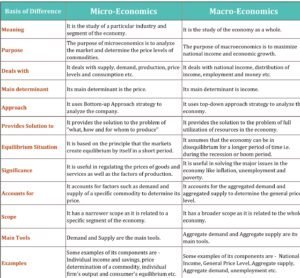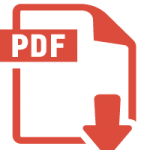The main difference between Micro Economics and Macro Economics is that Microeconomics is the study of the behaviour of individuals, households and firms whereas Macro Economics is the study of the economy as a whole. To understand its difference, first, we have to know the meaning of both terms:
Meaning of Micro-Economics :
It is a branch of economics that studies the economic behaviour of a specific person, a single firm or a company. It deals with the small scale economic activities of individuals or company.
Meaning of Macro-Economics:
It is a branch of economics that studies the structure, performance, behaviour and decision making activities of an economy as a whole. It focuses on regional, national as well as a global scale rather than focusing on individuals’ activities.
Chart of Difference between Micro-Economics and Macro-Economics: –
|
Basis of Difference |
Micro-Economics |
Macro-Economics |
Meaning |
It is the study of a particular industry and segment of the economy. | It is the study of the economy as a whole. |
Purpose |
The purpose of microeconomics is to analyze the market and determine the price levels of commodities. | The purpose of macroeconomics is to maximize national income and economic growth. |
Deals with |
It deals with supply, demand, production, price levels and consumption etc. | It deals with national income, distribution of income, employment and money etc. |
Main determinant |
Its main determinant is the price. | Its main determinant is income. |
Approach |
It uses a Bottom-up Approach strategy to analyze the company. | It uses the top-down approach strategy to analyze the economy. |
Provides Solution to |
It provides the solution to the problem of “what, how and for whom to produce” | It provides the solution to the problem of full utilization of resources in the economy. |
Equilibrium Situation |
It is based on the principle that the markets create equilibrium by themselves in a short period. | It assumes that the economy can be in disequilibrium for a longer period of time i.e. during the recession or boom period. |
Significance |
It is useful in regulating the prices of goods and services as well as the factors of production. | It is useful in solving the major issues in the economy like inflation, unemployment and poverty. |
Accounts for |
It accounts for factors such as demand and supply of a specific commodity to determine its price. | It accounts for the aggregated demand and aggregated supply to determine the general price level. |
Scope |
It has a narrower scope as it is related to a specific segment of the economy. | It has a broader scope as it is related to the whole economy. |
Main Tools |
Demand and Supply are the main tools. | Aggregate demand and Aggregate supply are its main tools. |
Examples |
Some examples of its components are – Individual income and savings, price determination of a commodity, individual firm’s output and consumer’s equilibrium etc. |
Some examples of its components are – National Income, General Price Level, Aggregate supply, Aggregate demand, unemployment etc. |
Download the chart: –
If you want to download the chart please download the following image and PDF file:-


Conclusion: –
Thus, Microeconomics and Macroeconomics, both these terms deal with the allocation of resources. Both terms study how the resources should be allocated among many consumers to provide the utility. The economic events covered under both are same but differ in how and why these are to be analyzed by the economists.
Advertisement-X
Thanks Please share with your friends
Comment if you have any question.
Check out Business Economics Books @ Amazon







Leave a Reply